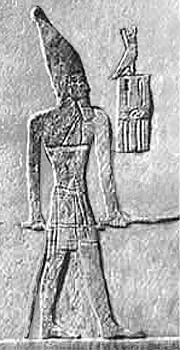Djoserteti, Djoserti

Sekhemkhet, whose name means "the strong one", had also the name Djeserty ankh (according to third dynasy expert Nabil Swelim). He became known in 1952 when the lower parts of his step pyramid was found in Sakkara less than a hundred meters to the south-west of pharaoh Djoser's pyramid complex. The work had stopped probably because the king died. When the grave chamber was entered it only contained just a white marble sarcophagus with a unique feature never to be seen in Egyptian history: a sliding panel at the gable instead of a top lid.
When it was opened it was found empty. A grave south of the pyramid held the remnants of a young boy of about four years of age, buried in a wooden coffin. Old Egyptian canons and scholars of today's give him a reign of between 6 and 8 years.
See also the Table of Swelim.
(Sekhhemkhet main text)
When it was opened it was found empty. A grave south of the pyramid held the remnants of a young boy of about four years of age, buried in a wooden coffin. Old Egyptian canons and scholars of today's give him a reign of between 6 and 8 years.
See also the Table of Swelim.